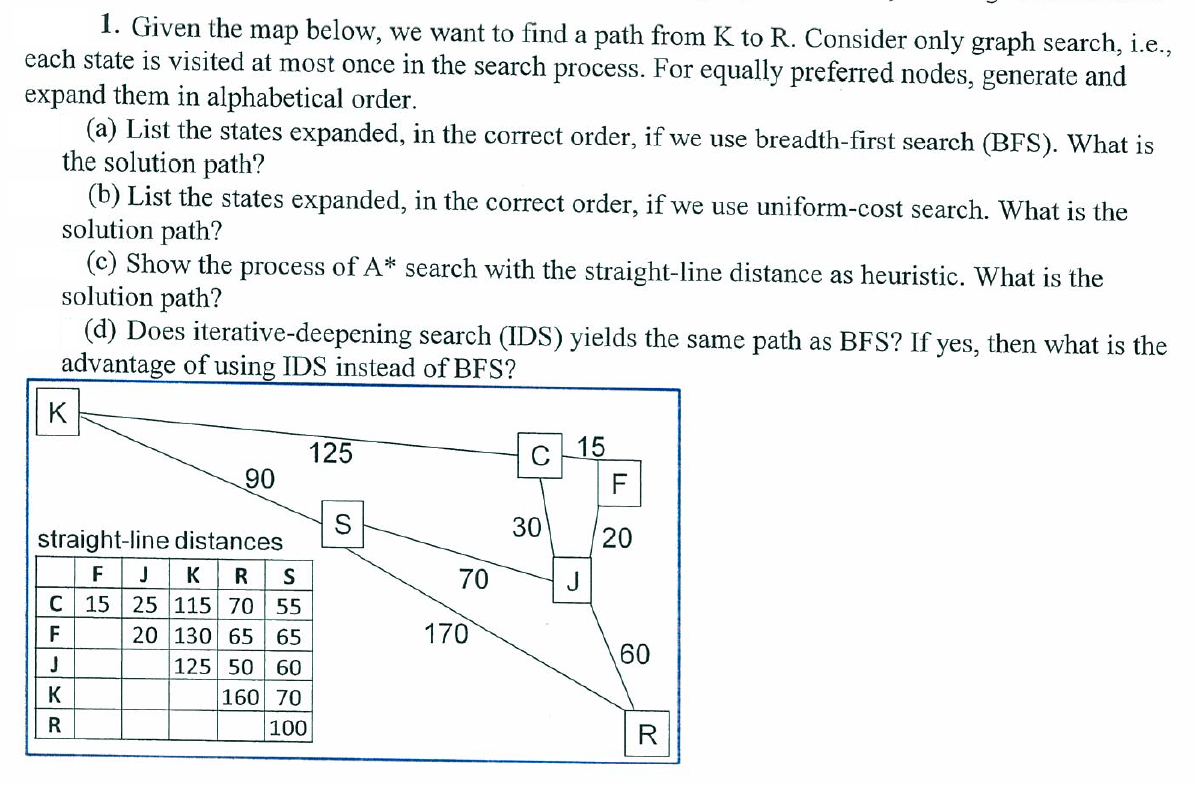1. Given the map below, we want to find a path from K to R. Consider only graph search, i.e each state is visited at most once in the search process. For equally preferred nodes, generate and expand them in alphabetical order. (a) List the states expanded, in the correct order, if we use breadth-first search (BFS). What is the solution path? (b) List the states expanded, in the correct order, if we use uniform-cost search. What is the solution path? (c) Show the process of A* search with the straight-line distance as heuristic. What is the solution path?
1. Given the map below, we want to find a path from K to R. Consider only graph search, i.e each state is visited at most once in the search process. For equally preferred nodes, generate and expand them in alphabetical order. (a) List the states expanded, in the correct order, if we use breadth-first search (BFS). What is the solution path? (b) List the states expanded, in the correct order, if we use uniform-cost search. What is the solution path? (c) Show the process of A* search with the straight-line distance as heuristic. What is the solution path?
Database System Concepts
7th Edition
ISBN:9780078022159
Author:Abraham Silberschatz Professor, Henry F. Korth, S. Sudarshan
Publisher:Abraham Silberschatz Professor, Henry F. Korth, S. Sudarshan
Chapter1: Introduction
Section: Chapter Questions
Problem 1PE
Related questions
Question
100%
[7_B_1]
Please answer this question step by step

Transcribed Image Text:1. Given the map below, we want to find a path from K to R. Consider only graph search, i.e.,
each state is visited at most once in the search process. For equally preferred nodes, generate and
expand them in alphabetical order.
(a) List the states expanded, in the correct order, if we use breadth-first search (BFS). What is
the solution path?
(b) List the states expanded, in the correct order, if we use uniform-cost search. What is the
solution path?
(c) Show the process of A* search with the straight-line distance as heuristic. What is the
solution path?
(d) Does iterative-deepening search (IDS) yields the same path as BFS? If yes, then what is the
advantage of using IDS instead of BFS?
K
125
C
15
90
F
straight-line distances
30
20
F
J
K
R
S
70
J
С 15
25 115 70 55
170
20 130 65
125 50
F
65
60
60
K
160 70
R
100
Expert Solution
This question has been solved!
Explore an expertly crafted, step-by-step solution for a thorough understanding of key concepts.
Step by step
Solved in 3 steps with 3 images

Knowledge Booster
Learn more about
Need a deep-dive on the concept behind this application? Look no further. Learn more about this topic, computer-science and related others by exploring similar questions and additional content below.Recommended textbooks for you

Database System Concepts
Computer Science
ISBN:
9780078022159
Author:
Abraham Silberschatz Professor, Henry F. Korth, S. Sudarshan
Publisher:
McGraw-Hill Education

Starting Out with Python (4th Edition)
Computer Science
ISBN:
9780134444321
Author:
Tony Gaddis
Publisher:
PEARSON

Digital Fundamentals (11th Edition)
Computer Science
ISBN:
9780132737968
Author:
Thomas L. Floyd
Publisher:
PEARSON

Database System Concepts
Computer Science
ISBN:
9780078022159
Author:
Abraham Silberschatz Professor, Henry F. Korth, S. Sudarshan
Publisher:
McGraw-Hill Education

Starting Out with Python (4th Edition)
Computer Science
ISBN:
9780134444321
Author:
Tony Gaddis
Publisher:
PEARSON

Digital Fundamentals (11th Edition)
Computer Science
ISBN:
9780132737968
Author:
Thomas L. Floyd
Publisher:
PEARSON

C How to Program (8th Edition)
Computer Science
ISBN:
9780133976892
Author:
Paul J. Deitel, Harvey Deitel
Publisher:
PEARSON

Database Systems: Design, Implementation, & Manag…
Computer Science
ISBN:
9781337627900
Author:
Carlos Coronel, Steven Morris
Publisher:
Cengage Learning

Programmable Logic Controllers
Computer Science
ISBN:
9780073373843
Author:
Frank D. Petruzella
Publisher:
McGraw-Hill Education